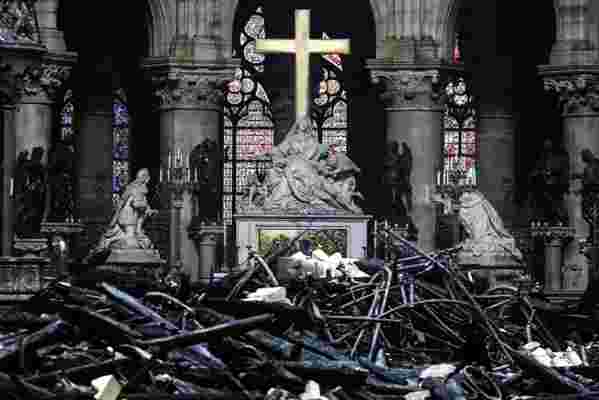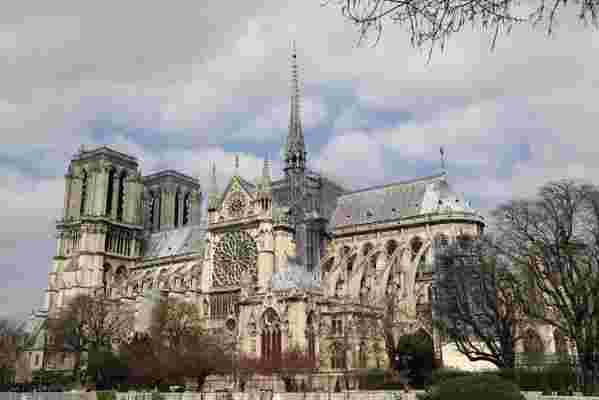Paris is a city like no other, and much of this has to do with its spectacular architecture. But yesterday Notre-Dame cathedral, one of its most iconic structures, caught fire for several hours, nearly destroying the centuries-old church before firefighters were able to extinguish the fire. The symbolism of flames destroying a sacred landmark was hard to miss as France has been a place of tension and turmoil for months with its “Yellow Vest” protestors dominating local and national headlines. The tragedy all began when fire alarms rang Monday evening as commuters rushed past the Notre-Dame cathedral on their way home. Yet upon seeing the smoke, and then later the billowing flames, a large crowd gathered in horror as it watched the spire of the famous cathedral collapse as the fire grew in size and intensity. According to The Washington Post , heat from the flames could be felt from across the River Seine, several hundred feet from the cathedral.
Late Monday evening, President Emmanuel Macron addressed a large crowd that had gathered before the charred church. “It is a terrible tragedy . . . Notre-Dame is the cathedral of all French [people]. . . . [It is] the epicenter of our life.” Macron later praised the “extreme courage” of the firefighters who battled, and eventually quelled, the flames.

People watch the landmark Notre-Dame Cathedral burning in central Paris.
While it remains unclear what started the fire, the cathedral has been under a $6.8 million renovation project (including the now-collapsed spire). Many officials are considering the blaze an accident relating to construction. It’s unlikely that the fire was arson, even though there has been an uptick in the number of Catholic churches that have been victims of vandalism and arson over the past few years. Nevertheless, investigators have promised a thorough investigation to determine the cause of the fire. Regardless of how it began, the age and materials within the church certainly didn’t help contain the fire. “Arguably the most dangerous place for a fire to begin in any given city is a place of worship,” says Vincent Dunn, a former New York City fire chief (whose jurisdiction included the city’s beloved St. Patrick’s Cathedral). “While these buildings are unbelievably beautiful, they were often built before building codes existed.” Yesterday’s fire at Notre-Dame started in or near the spires some 295 feet from the ground. According to Dunn, this was extremely problematic for two reasons. “If you’ve ever been in the attic of a church, you’ll instantly notice it’s all made of wood, which of course makes it ripe for a fire to spread quickly. Second, fire hoses can only reach a maximum height of fifty feet, making the spires in Notre-Dame extremely difficult to address.”
There was a point yesterday when the world collectively held its breath as the fate of Notre-Dame was very much unclear. Yet Parisian firefighters prevailed, eventually saving the entire structure from total destruction. “The firefighters used both an offensive and defensive strategy,” explains Dunn. “First, from the outside, they had aerial streams hitting the fire from several safe locations to contain the flames and prevent them from spreading to nearby structures. Then, they switched strategies to an inside one in which an offensive search-and-recover operation began. They did a great job.”
Which brings us to the difficult but important discussion of what to do moving forward with the countless other places of worship around the world. “If centuries-old places of worship want to protect their buildings, they must install automatic sprinklers,” Dunn argues. “The problem is, no one wants to do that because it could deface the beautiful interiors. But that’s really the only way they can ensure their structure will last another century. If they don’t take this problem seriously, any other places of worship around the world could suffer the fate as Notre-Dame.”

An image shows charred debris inside the Notre-Dame Cathedral in the aftermath of a fire that devastated the cathedral.
With this in mind, one must consider the question as to whether places of worship are suitable for housing priceless historic relics. Would it be in the public’s interest to move them to museums, for example, where their preservation is significantly more certain? “It’s certainly an interesting question, and one that has valid points on either side of the debate,” says Samantha Herrick, associate professor of history at Syracuse University (Herrick specializes in the Middle Ages). “On one hand, there would really be no substitute for a relic—medieval pilgrims did not go to shrines to see a copy of a saint’s relics; they went to be close to what they believed was the real thing.” And for the modern tourist who visits places such as Notre-Dame Cathedral? “Of course, most modern tourists do not go to historic churches as pilgrims,” says Herrick. “So there is a case to be made for placing those objects, as well as others not claiming to be holy, in safekeeping and replacing them with replicas. But at what point does a church or other religious monument cease to be a sacred site?”

A picture taken last month shows a scaffold during the renovation of Notre-Dame in Paris.
Notre-Dame cathedral, which is located in the fourth arrondissement of Paris, was originally completed in 1260. Parts of the medieval church were destroyed during the French Revolution. A quarter-century-long renovation took place, finally ending in 1870. The church remained relatively untouched until the end of the 20th century when restoration crews set out to clean and maintain parts of the structure. The spire was not part of the original structure, but a replacement for a previous spire that was dismantled.
One of the many reasons Monday’s fire was such a heartbreaking event is the significance of the structure in French culture. “Notre-Dame is one of the largest of a group of medieval churches located in the Ile-de-France and vicinity that developed and refined the audacious building techniques of the high Middle Ages that we know as Gothic architecture,” says Jean-François Bédard, associate professor of architecture at Syracuse University (Bédard specializes in French architecture). “This included a desire for high naves designed to let in the mysterious, Godly, colored light of stained glass windows, as the great rose window of Notre-Dame’s west façade attests wonderfully.”
The Consecration of the Emperor Napoleon (1807) by Jacques-Louis David depicts the moment Napoleon Bonaparte was crowned emperor inside of Paris's Notre-Dame Cathedral in 1804.
Not only is the church an icon of French Gothic architecture, but many notable events took place within its hallowed walls. In 1431, Henry VI of England was made king of France inside Notre-Dame. It was nearly four-hundred years later when Napoleon Bonaparte was crowned emperor there in 1804, which was depicted in a famous painting by Jacques-Louis David entitled The Coronation of Napoleon (1807). Just after the turn of the century, in 1909, Joan of Arc was beatified in the cathedral by Pope Pius X. After the end of World War II, a thanksgiving ceremony took place within its tall walls. The dinner was led by Charles de Gaulle, the man who led the French Resistance against Nazi Germany, helping to liberate the city in 1944.
As images of the fire engulfing the historic church circulated the globe through social media and news outlets on Monday, it was difficult not to draw correlations with Brazil’s heartbreaking museum fire in 2018. Similar to the National Museum of Brazil, Paris’s Notre-Dame cathedral is woven into the cultural thread of the city. Already a massive outpouring from such high-profile people as Apple’s Tim Cook and French billionaire Bernard Arnault have pledged hundreds of millions in donations to rebuild the iconic church.
As for the immediate days and months to follow, many outstanding questions will remain. Some will be answered, many more likely won’t. In times like this, it seems important to look back on wise words to find solace. Indeed, as Victor Hugo wrote in his novel The Hunchback of Notre-Dame (1831), “The greatest products of architecture are less the works of individuals than of society; rather the offspring of a nation’s effort, than the inspired flash of a man of genius.”

Leave a Reply